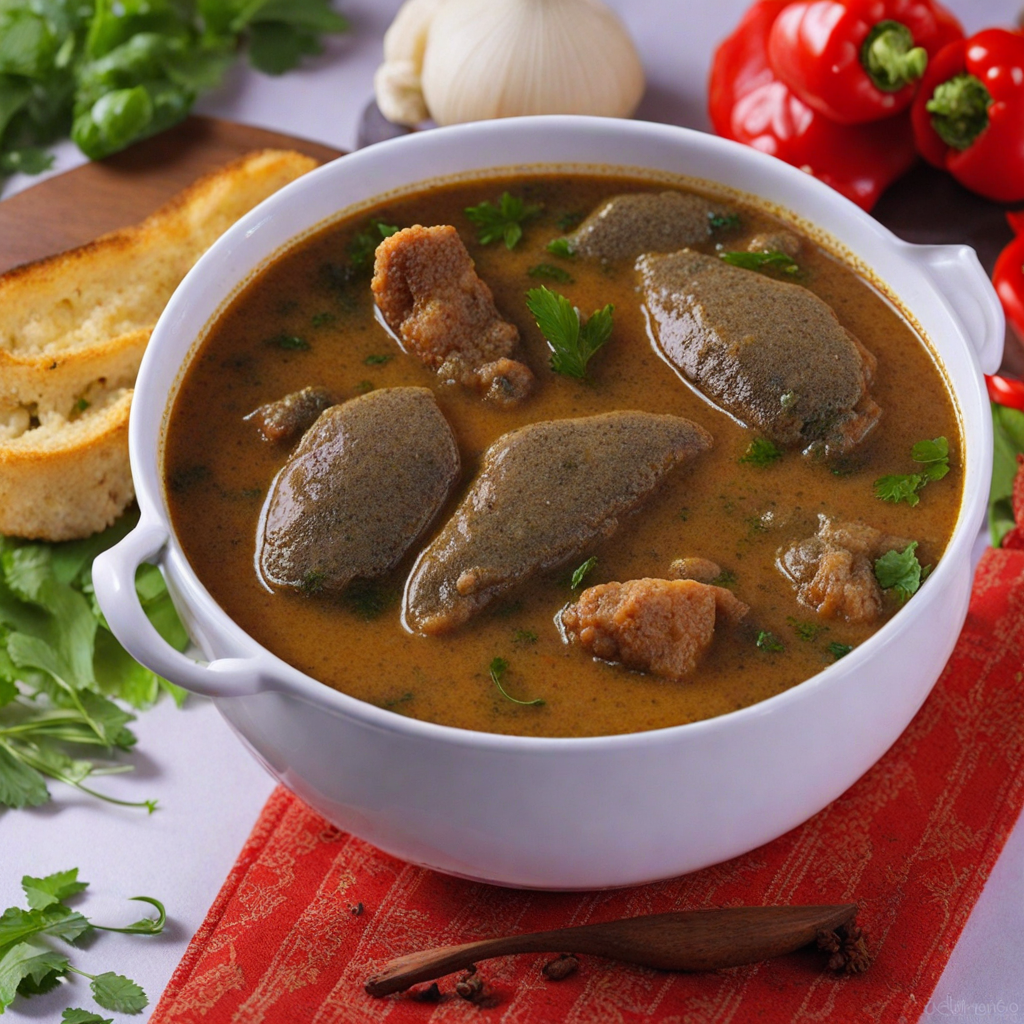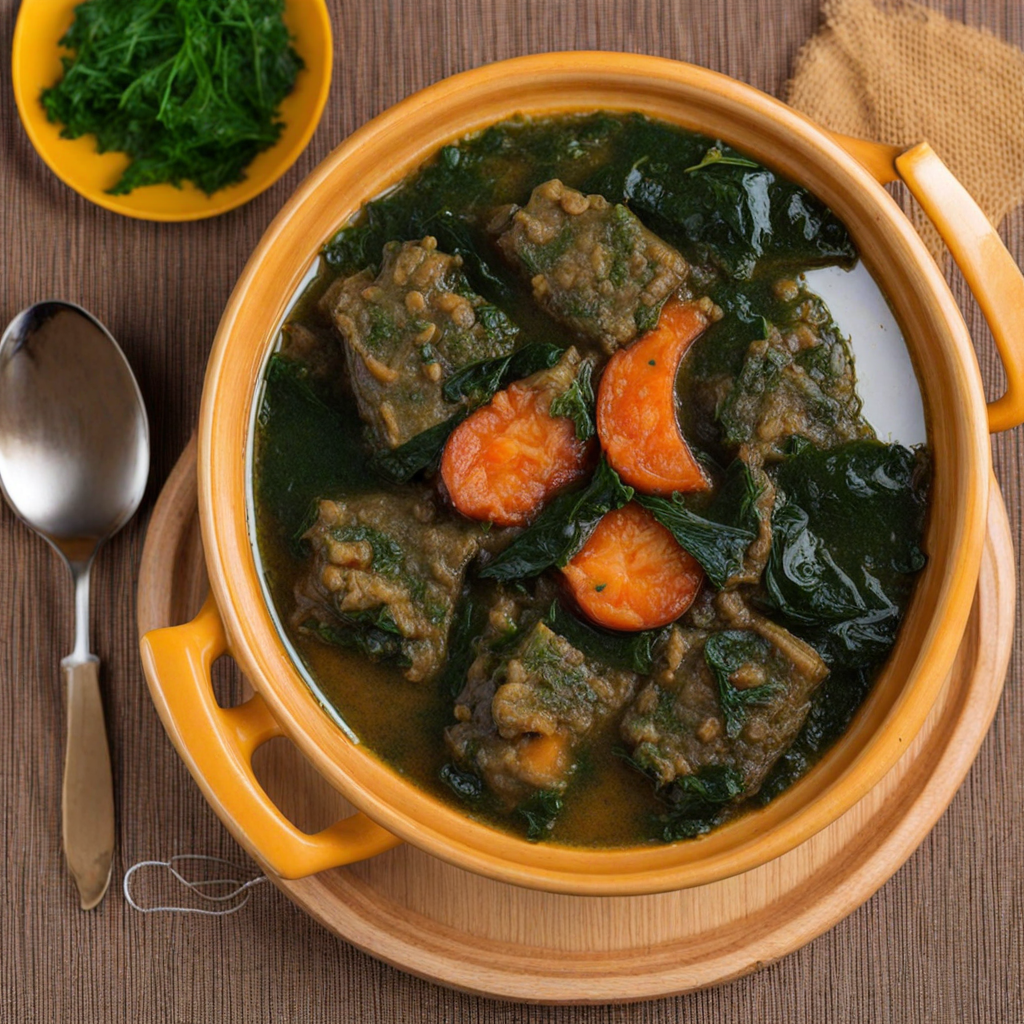Agidi
Agidi is a traditional Nigerian dish that showcases the culinary richness of the country, particularly among the Yoruba and Ibo people. This dish is primarily made from cornmeal or cassava flour, which is mixed with water and cooked to create a thick, smooth, and gelatinous texture. The preparation involves stirring the mixture continuously until it thickens, resulting in a firm consistency that can be molded into various shapes. Agidi is often served as a side dish, providing a neutral base that complements savory stews and sauces, making it a versatile staple in Nigerian cuisine. One of the key aspects of Agidi is its ability to absorb flavors from accompanying dishes. It is typically enjoyed with rich, spicy sauces such as Egusi (melon seed soup) or Ofe Nsala (white soup), allowing the mildly flavored Agidi to balance the heat and complexity of the sauces. The subtle corn or cassava flavor acts as a canvas that enhances the overall dining experience, making each bite a delightful fusion of tastes. Additionally, Agidi can be enjoyed with grilled or fried protein, such as fish or chicken, adding a satisfying element of texture and taste to the meal. Agidi can also be approached creatively; it can be sliced into shapes and served cold, often featuring in salads or as a snack. Some variations include incorporating spices or vegetables directly into the mix before cooking, creating unique flavor profiles. This adaptability makes Agidi not only a beloved traditional food but also a canvas for modern culinary experimentation, inviting food lovers to explore its potential in both classic and contemporary dishes.
How It Became This Dish
The History of Agidi: A Culinary Journey through Nigeria Agidi, a traditional Nigerian dish, is a starchy staple that showcases the rich agricultural heritage and culinary diversity of the country. Made primarily from maize flour or cornmeal, Agidi is characterized by its firm, gelatinous texture, which makes it a versatile accompaniment to a variety of soups, stews, and sauces. Its history is deeply rooted in the agricultural practices of Nigeria, reflecting the cultural and social dynamics of the regions where it is most commonly prepared and consumed. #### Origins of Agidi The origins of Agidi can be traced back to the indigenous farming communities of Nigeria, particularly in the southern and eastern regions where maize is a staple crop. Maize, believed to have been introduced to West Africa from the Americas in the 16th century, quickly adapted to the local environment and became an integral part of the Nigerian diet. The cultivation of maize flourished, leading to the development of various dishes, including Agidi. Agidi itself is thought to have emerged as a practical solution to the need for a filling, nutritious food that could be prepared using readily available ingredients. The simplicity of its preparation—boiling maize flour in water until it thickens into a porridge-like consistency—made it an accessible dish for families across different socio-economic backgrounds. #### Cultural Significance Agidi holds a special place in the hearts and homes of many Nigerians. It is not merely a dish but a symbol of hospitality and community. Traditionally, Agidi is served during family gatherings, celebrations, and ceremonial occasions, often accompanied by rich, flavorful soups such as Ofe Nsala (white soup) or Egusi (melon seed soup). The preparation and sharing of Agidi during these events foster a sense of unity and togetherness among family and friends. In many cultures within Nigeria, food is a vital part of identity. Agidi, with its humble origins, reflects the resourcefulness and resilience of the Nigerian people. It is a dish that transcends social class and regional boundaries, being enjoyed by both the affluent and the less privileged. In this way, Agidi serves as a culinary equalizer, reinforcing the idea that food can bring people together regardless of their backgrounds. #### Preparation and Variations The preparation of Agidi is relatively straightforward but requires a certain level of skill and attention. The maize flour is mixed with water to create a smooth batter, which is then boiled while being continuously stirred to prevent lumps from forming. The result is a thick, smooth mass that can be poured into molds or left to set in a dish. Once cooled, Agidi can be sliced into firm blocks or served as a soft porridge. Over time, various regional adaptations of Agidi have emerged, incorporating local ingredients and flavors. In some areas, Agidi is enhanced with spices or herbs, adding depth and complexity to its flavor profile. Additionally, some communities have begun to experiment with alternative grains, such as cassava flour, to create gluten-free versions of Agidi, further broadening its appeal and accessibility. #### Agidi in Modern Nigeria As Nigeria has evolved, so too has the role of Agidi within its culinary landscape. In urban areas, the dish has seen a resurgence as a comfort food, often featured in restaurants and food stalls catering to a younger generation seeking traditional flavors. The rise of social media has also played a pivotal role in popularizing Agidi, as food enthusiasts share recipes, cooking tips, and photos, making the dish more visible to a global audience. Furthermore, Agidi has transcended its role as a mere accompaniment to soups and stews. Chefs and home cooks alike have begun to experiment with Agidi, incorporating it into modern dishes. It can now be found in fusion recipes, such as Agidi served with grilled meats or stir-fried vegetables, showcasing its versatility and adaptability to contemporary culinary trends. #### The Future of Agidi Looking ahead, Agidi's future appears bright. As the world becomes increasingly interested in global cuisines, the rich flavors and cultural significance of Nigerian dishes are gaining attention. Agidi, with its simple ingredients and comforting texture, is likely to find a place in the hearts and stomachs of food lovers beyond Nigeria. Moreover, as conversations around food sustainability and local sourcing grow, Agidi’s reliance on maize—an easily cultivated crop—positions it well within the context of sustainable eating. The dish not only reflects the agricultural bounty of Nigeria but also encourages the use of local produce, supporting farmers and local economies. In recent years, there has been a growing movement to preserve and promote traditional Nigerian foods, including Agidi, as part of the country's cultural heritage. Culinary schools and organizations are increasingly recognizing the importance of teaching these traditional dishes to the next generation, ensuring that the knowledge and skills surrounding Agidi are passed down. #### Conclusion Agidi is more than just a dish; it is a testament to Nigeria's rich agricultural history and cultural heritage. From its humble beginnings in local farming communities to its place on modern tables, Agidi embodies the spirit of resilience, community, and adaptability. As Nigeria continues to evolve, so too will Agidi, ensuring that this cherished staple remains a significant part of the nation's culinary landscape for generations to come. Whether served in a traditional setting or reimagined in a contemporary dish, Agidi will always hold a special place in the hearts of those who savor its unique, comforting flavor.
You may like
Discover local flavors from Nigeria







